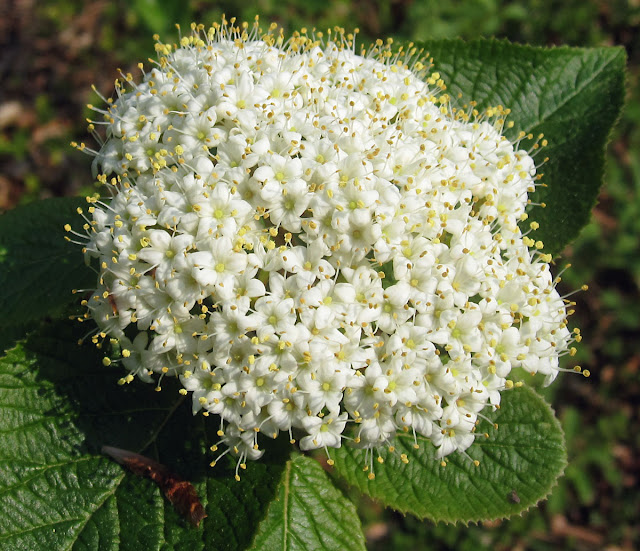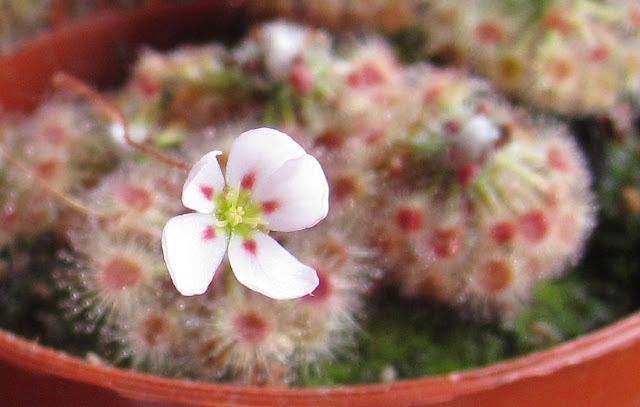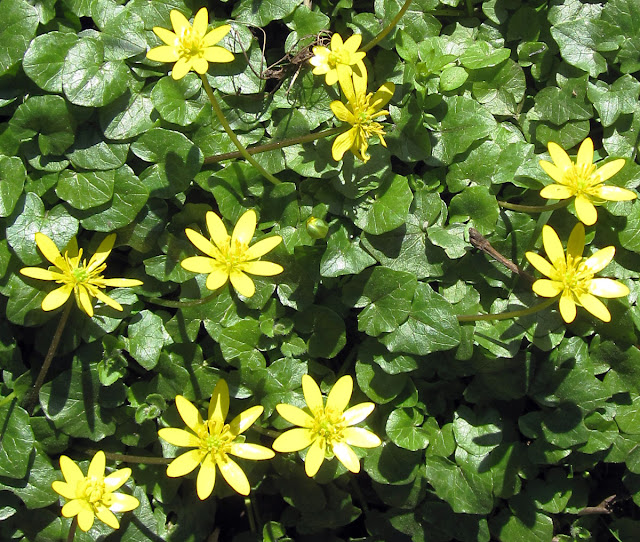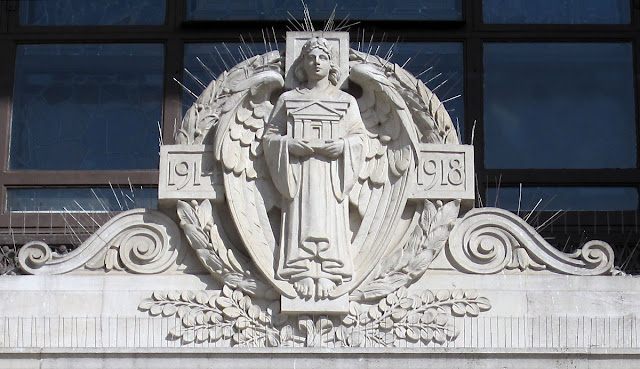 |
| Wolf spider on a log in Thornet Wood, Jubilee Country Park. April 2011. |
Saturday, 30 April 2011
Wolf Spider
Labels:
invertebrates,
Jubilee Country Park,
mini-beasts,
spiders
Friday, 29 April 2011
Forget-me-not
 |
| Forget-me-not, Myosotis species, self-seeded in a garden in Hayes. 15 April 2011. |
 |
| I thought this was a forget-me-not too, but it turns out to be Pentaglottis sempervirens, also called green alkanet or evergreen bugloss. It seeds readily and is common in this area. 20 April 2011. |
Thursday, 28 April 2011
Coppiced Oak
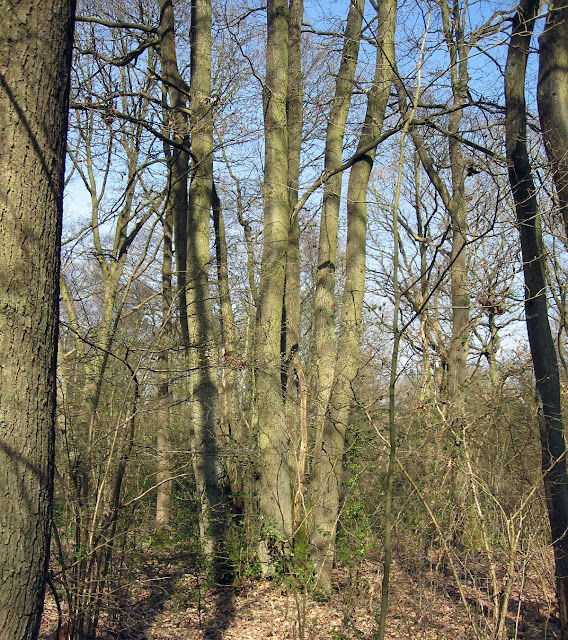 |
| A scarce coppiced oak in Sparrow Wood, Bromley, providing six tall straight trunks instead of one. 24 March 2011. |
Wednesday, 27 April 2011
Moving A Star
 |
| Silver denarius of Elagabalus. SVMMVS SACERDOS AVG. |
These denarii have the emperor on both sides. The usual imperial headshot is on the obverse, with one odd change from tradition: the strange horn attached above his forehead. No-one really knows what this was, but it must have been connected to his religion in some way.
 |
| Silver denarius of Elagabalus. P M TR P IIII COS III P P. |
On both coins you can see a star in front of the emperor and a blurred area behind him. A star like this usually means divinity. The meaning of the blur was discovered by Curtis Clay, who wrote: "the engraver first placed the 'star' behind the emperor, then eradicated it in the die and re-engraved it in front of the emperor, obviously because it represents the emperor's sun god, so should be placed before him when he is depicted sacrificing to his god!"
You can see that the new star is engraved more deeply and emphatically than the old one, probably to distract attention from it.
Mr. Clay also wrote: "There are quite a few dies of each of the four 'emperor-sacrificing' types on which this correction was made, and NO surviving coins of these regular types with the star erroneously behind the emperor. On the rare first versions of the types, in contrast (...) the star is invariably wrong, that is behind the emperor rather than in front of him. The eradicated star dies are obviously the first of the new types, as confirmed by the portrait of the emperor, with moustache but still without beard, whereas most coins of these types show the chin beard."
 |
| Silver denarius of Elagabalus. SVMMVS SACERDOS AVG. |
Coin dies were very rarely altered. Unless the alteration was minor it would have been quicker and cheaper to make a new die. But here we have a clear example. I have had one of these, with Curtis Clay's explanation, for a while, but as I have just obtained my second example I thought it was worth posting here.
Tuesday, 26 April 2011
Monday, 25 April 2011
Sun Spurge And Ant
 |
| Sun Spurge, Euphorbia helioscopa, in High Elms Country Park. An ant is harvesting pollen. 25 April 2011. |
Labels:
flowers,
High Elms,
insects,
invertebrates,
mini-beasts
Sunday, 24 April 2011
Bluebells
 |
| Common (English) bluebell, Hyacinthoides non-scripta; the native species. Spring Park, 16 April 2011. Used to be named Endymion non-scriptum. |
 |
| Detail of a common bluebell. Spring Park, 16 April 2011. |
 |
| Spanish bluebell hybrid, the invader species. Hayes, 15 April 2011. |
Saturday, 23 April 2011
Friday, 22 April 2011
Spring Park Lumps
 |
| Coppiced hazel, last cut 4 winters ago, and standard oaks in Spring Park. |
Spring Park is in two sections. The hillside section is wooded, 35 acres, and between the hill and the road are 15 acres of meadow. Both the woods and the meadow extend beyond the park into areas which are the responsibility of local councils. Some of the Council-managed areas are used for recreation, some are managed as natural areas. All, including Spring Park, are popular with the locals, particularly dog walkers.
 |
| Oak catkins in Spring Park. 22 April 2011. |
In the past, hazel would have been used for charcoal. The tall oaks scattered through the woods — 40 per acre — were also a crop, and would have been used in ship and house construction. They would have been harvested at about the size these are now, or a bit sooner.
Woodland management of this sort was neglected before 1987, but the hurricane-strength winds that blew down so many trees made it essential to do something; the woods were closed to the public all that winter until dangerous areas could be cleared. And it was decided then to re-start coppice management.
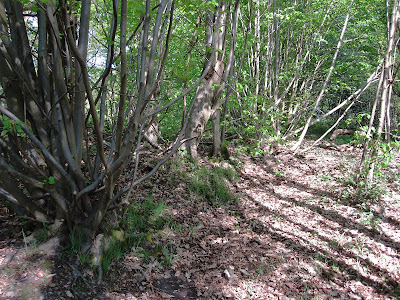 |
| A bank and ditch at the border of Spring Park, with small-leaved limes. |
A number of other trees are scattered through the woods. There are some old yews, and some newer incomers like cherries, white beam, rowan and silver birch, which add pleasantly to the diversity of the area.
Small-leaved limes are well embedded here. This is a scarce tree (in nature) and a good sign of an ancient woodland. They need very warm summers to produce seeds, so seedlings are rare; Barry knows of only three in this wood. Luckily for the species, they are very good at producing suckers and will also regrow from the base if the original trunk dies back, rather like a natural coppice.
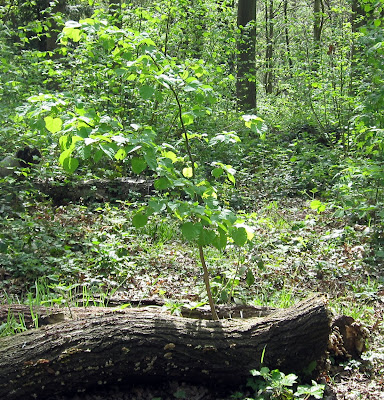 |
| Seedling of a small-leaved lime in Spring Park. 22 April 2011 |
It runs down the hill at the border between Bromley and Croydon councils, probably at one time the border of Kent and Surrey. These trees were all pollards before 1987, but when some were blown down they were cut back and have regrown from ground level. Small-leaved limes were harvested for use in rope-making.
I saw many splendid flowers in the woods. There are thousands of bluebells just reaching their peak, as well as areas of lesser celandine and wood anemone, almost finished flowering. There was some herb Robert, and many yellow archangels, which like the bluebells are a good sign of an ancient woodland. These are spreading well in newly coppiced areas. Also flowering along the paths and at the margins were white dead-nettle, greater stitchwort, cow parsley, buttercups and dandelions. Among the trees, the oaks were covered with catkins, and there were masses of creamy flowers on the rowans.
 |
| Photograph of Spring Park and surroundings taken by the Luftwaffe in 1942. Click on it to see it enlarged. |
You can see a few dark dots bisecting the meadow top to bottom. That is the line of an old hedgerow, which the rangers plan to reinstate this coming winter, with a pleasant mix of hawthorns, blackthorns, hazel and spindle — all local hedgerow species.
As you can see, this was a very interesting and informative walk, and lots of questions were asked and answered. The City of London has a web page on Spring Park here: Spring Park.
 |
| Barry Gutteridge pointing out a pollarded small-leaved lime to the group. Spring Park, 22 April 2011. |
Labels:
City Commons,
environment,
Spring Park,
trees,
walks
Thursday, 21 April 2011
Wednesday, 20 April 2011
No Cuts
 |
| A man repairing a No Cuts protest on the river bank below the Hungerford Bridge, London. 19 April 2011. See this web page: No Cuts Artwork. |
Tuesday, 19 April 2011
Mouse Under Book
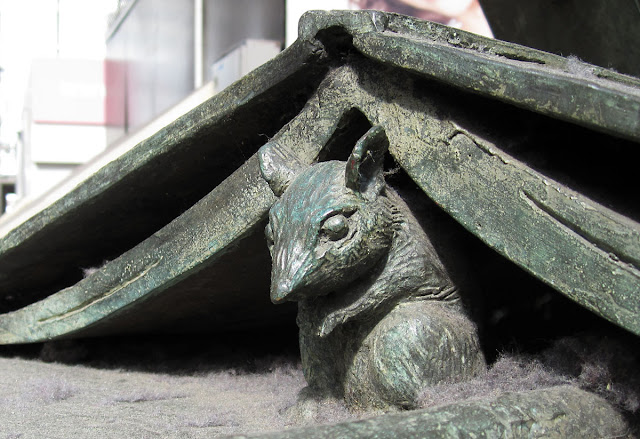 |
| Detail at the back of the statue of Terence Tenison Cuneo by Philip Jackson in Waterloo Station, London. I do not think that this statue is cleaned very often. |
Monday, 18 April 2011
High Elms Woodlouse
Sunday, 17 April 2011
History Walk in Jubilee Country Park
 |
| Jennie Randall addressing the group on her Jubilee Country Park history walk. 17 April 2011. |
The walk was formatted as a gentle stroll from place to place, with frequent stops while Jennie told us facts and stories, meticulously working through her notebook, handing out copies of maps and photos for all to see. I won't even try to repeat everything she told us, just mention a few details.
The park is a patchwork of woodland, open meadow, and ponds. It has a mixed historical background and a rich natural history, parts of which are mentioned elswehere on this blog. (Look for the subject label in one of the boxes on the right.) The park wasn't always a single entity; parts of it were owned by different families, then it was a golf course, and it has been the site of an anti-aircraft battery; twice it has almost had a housing estate built on it. Now it is owned by Bromley Council and is a Local Nature Reserve.
 |
| One of the old golf course bunkers, now an occasional pond. |
A bronze age axe-head was discovered in one area, which was used as allotments during the war as part of the "dig for victory" campaign. It could be 3,500 years old; this was the oldest item we were told about. That area, the Signal Box area, is now recovering woodland.
Next in line would be the oldest tree in the park, a pollarded oak that was planted around 1660; it once was part of a row of similar trees forming a boundary line.
Skipping gaily past a good deal of interesting material: the anti-aircraft battery was placed during WWII and included four naval guns with a 15-mile range, so powerful that during test firing they broke tiles and brought ceilings down in nearby houses. The guns were worked at various times by Royal Marines, Royal Artillery, Home Guard and the women of the ATS. A set of barracks nearby was used as emergency accommodation after the war. Some information about this gun emplacement is on a history board near the site.
 |
| The oldest tree in the park; a pollarded oak dating from around 1660 |
Recent history, World War II and after, is where Jennie has gathered most material, as she has been able to speak to people who were there and collect their memories. In fact she is writing a book about the events at the nearby Crooked Billet, which was destroyed by a German V-2 ballistic missile. A plaque on the rebuilt pub, commemorating this event, is to be unveiled on 21st May.
A final random fact: in 1873 the novelist George Eliot took a house on the edge of the park. However, due to a problem with getting it furnished, the house felt unwelcoming and she did not stay long, even though she liked the surrounding area.
If you want to know the rest, watch out for the next history walk on the Friends site ...
 |
| The history notice board, with information about the WWII gun emplacement. Click on it to see it enlarged. |
Saturday, 16 April 2011
Crackle and Pop
The thing about bat walks is that there are no photos. They take place after sunset, and torches and flashes are discouraged because they ruin peoples' night vision. But they are wonderful.
The walk on 16th April was in Kelsey Park, Beckenham. It was organised by the Friends of the park and led by Ishpi Blatchley, a local lichen and bat expert. The park is closed at night, so we were locked in for the duration of the walk.
Ishpi gave her usual talk about bats, their nature and habits, and we wandered around listening on heterodyning bat detectors for their supersonic echolocating calls. At first we heard the commonest British bats, common pipistrelles, and saw some against the sky flitting across clearings. When we came to an outlook over one of the lakes, we saw and heard a soprano pipistrelle, a little scarcer than common pips. Pipistrelles make a call that sounds like a fast series of hollow pops, very distinctive when you are familiar with it; at around 45 kilohertz for common pips, and 55 for the sopranos.
The real treat came when we approached the big lake. Not only was the air like bat soup, with pipistrelles flocking around the lake margin, but we heard one of the bigger bats, possibly a Leisler's or a Serotine. It was calling at about 27 khz, slower and louder than the pips. It circled around several times, but no-one got a reliable sighting. Ishpi recorded it and should be able to identify it later from an analysis of the recording.
This lake is a great place to see Daubenton's bats. These creatures are specialised to feed over water. They zoomed around the lake just above water level, and as they turned, followed by a guide's torch beam (strictly pointed away from us at low level) we could see their white bellies. They have big hairy feet with which they can catch insects, but they were too far away for us to see this detail.
Daubenton's bats call at about 40 kilohertz and make more of a crackling sound on the detector, almost sounding like radio interference with the pipistrelles, which of course were calling at the same time. Tuning into bat calls is very like tuning an old-fashioned long wave radio; they are both heterodyning devices.
Since first going on a bat walk last year I have become much more aware of their presence. And pipistrelles are easy to find. Last week I was standing on my balcony at night watching my cat wander around my tiny garden, and three of them flew less than two metres over my head; first one, then two more. Magic.
The walk on 16th April was in Kelsey Park, Beckenham. It was organised by the Friends of the park and led by Ishpi Blatchley, a local lichen and bat expert. The park is closed at night, so we were locked in for the duration of the walk.
Ishpi gave her usual talk about bats, their nature and habits, and we wandered around listening on heterodyning bat detectors for their supersonic echolocating calls. At first we heard the commonest British bats, common pipistrelles, and saw some against the sky flitting across clearings. When we came to an outlook over one of the lakes, we saw and heard a soprano pipistrelle, a little scarcer than common pips. Pipistrelles make a call that sounds like a fast series of hollow pops, very distinctive when you are familiar with it; at around 45 kilohertz for common pips, and 55 for the sopranos.
The real treat came when we approached the big lake. Not only was the air like bat soup, with pipistrelles flocking around the lake margin, but we heard one of the bigger bats, possibly a Leisler's or a Serotine. It was calling at about 27 khz, slower and louder than the pips. It circled around several times, but no-one got a reliable sighting. Ishpi recorded it and should be able to identify it later from an analysis of the recording.
This lake is a great place to see Daubenton's bats. These creatures are specialised to feed over water. They zoomed around the lake just above water level, and as they turned, followed by a guide's torch beam (strictly pointed away from us at low level) we could see their white bellies. They have big hairy feet with which they can catch insects, but they were too far away for us to see this detail.
Daubenton's bats call at about 40 kilohertz and make more of a crackling sound on the detector, almost sounding like radio interference with the pipistrelles, which of course were calling at the same time. Tuning into bat calls is very like tuning an old-fashioned long wave radio; they are both heterodyning devices.
Since first going on a bat walk last year I have become much more aware of their presence. And pipistrelles are easy to find. Last week I was standing on my balcony at night watching my cat wander around my tiny garden, and three of them flew less than two metres over my head; first one, then two more. Magic.
Greater stitchwort flower.
 |
| Greater stitchwort, Stellaria holostea, flowering in Hayes. 15 April 2011. It normally has five petals, but several flowers in this patch had six. |
Friday, 15 April 2011
Thursday, 14 April 2011
Spring at High Elms
 |
| Butterbur flowering at High Elms Country Park, 14 April 2011. |
Terry seemed to think that there was not much happening in the woods yet, though to my eye a lot was going on; if this is not much, it will be interesting to see how it looks in a couple of months. We saw many plants and flowers, some interesting, some beautiful, and some both.
The weather started to improve as we walked round the estate. First we came across a large patch of butterbur. The leaves of this plant, we were told, were used to wrap butter for Sir John Lubbock's house; the wrapped butter was then stored in the ice well. I looked butterbur up and found that the rhizomes and stalks are poisonous, so it's probably just as well that only the leaves were used.
 |
| Flower of Arum maculatum in High Elms Country Park. 14 April 2011. |
Nearby was some ground ivy, also called alehoof, which at one time was used to give flavour and bitterness to beer before hops came into use for the same purpose. Also, milkmaids, also called cuckoo flower or lady's smock. All of the local wild flowers have several names; they vary according to region and sometimes over time.
Many Arums (lords and ladies; cuckoo-pint) were flowering, but something, probably rabbits, had eaten out the spathes of most of them. We did find a few un-nibbled specimens. The local woods are full of this plant, so they must be able to spread successfully somehow.
 |
| Yellow archangel in flower. 14 April 2011. |
The spikes of showy vermilion berries will make a good display later in the year.
Today's prettiest flower to my eye was this yellow archangel, one of several types of wild dead-nettle on the estate.
Other plants we saw in flower included greater stitchwort, a white hedge flower; herb Robert, a wild cranesbill or geranium; sun spurge, Euphorbia helioscopia; primroses and cowslips; and we also saw the leaf rosettes of some spotted orchids, promising a good display later on. There were a couple of clumps of toothwort, a plant with no green parts that is parasitic on tree roots. I last saw some of this on Hang Grove Hill in Cudham Valley.
There is a pond with some familiar species, marsh marigold and bog bean, which I suspect were used to stock Ray's Pond in Jubilee Country Park; Jenny Price told me she got these plants from just such a pond.
 |
| Toothwort, Lathraea squamaria, in High Elms Country Park. 14 April 2011. |
If you look up spurge laurel you will see "All parts of the plants are poisonous. The sap is known to cause skin rashes on contact." So please take care. It has this and its small green flowers in common with the Euphorbias from which it takes its common name.
The estate also has many different trees, both native and non-native.
And one thing I have not yet mentioned; thousands of native bluebells. Here is one of the stretches of bluebell wood we walked past.
 |
| Bluebell woodland in High Elms Country Park. 14 April 2011 |
Wednesday, 13 April 2011
Tuesday, 12 April 2011
Marsh Marigold Flower
Monday, 11 April 2011
Sunday, 10 April 2011
Saturday, 9 April 2011
Mesh Fence Minutiae
 |
| Mesh fence on the Hayes to West Wickham railway path. March 2011. |
I walk along this path quite often and I wonder about this fence. Why is every other row fading to silver? The rows are apparently identical otherwise.
Well, first, the wires are not fading. Looking more closely shows that the strands are painted, and the paint is coming off in places. Then you can see that the fence is constructed of vertical strands which are woven together and fixed at the top and bottom by simple crimped loops.
The alternate rows you can see in the first photo are from alternate vertical strands. So the paint seems to have come off differentially on every alternate vertical strand.
How has this come about? It's not that the fence is being rubbed by passers-by, because the parts set back have lost at least as much paint as those at the front. Is it that during assembly, alternate vertical strands came from different rolls of wire, which were either rubbed differently or were made differently?
 |
| Detail of mesh fence showing paint coming off the strands |
Perhaps the paint starts to flake off as the strands expand and contract when heated by the sun and then cooled in the shade. I don't see the same effect on lengths of the fence that are always out of the sun. This would still require alternate strands to react differently to the same effect.
This still seems odd to me.
There is another thing about this fence. I didn't see the process of erection, and it looks continuous. It's too long to have arrived in one piece, so how was this seamlessness achieved? Suppose it came in rolls. The strands at the ends of each length must have been woven together by the installers, and if so, then there would be some of the connecting loops which look hand done. And indeed, there they are.
I feel quite pleased with myself, having worked out a hypothesis and found confirming evidence; even though this must be already quite obvious to some, and completely trivial to others. At least I am not totally clueless about the fence.
 |
| Detail of the top of the mesh fence, showing one hand-crimped junction and three machine-crimped junctions |
Friday, 8 April 2011
Wednesday, 6 April 2011
Tuesday, 5 April 2011
Apollo from Didyma
 |
| Bronze AE18 of Miletos in Ionia, c. 200 BCE |
These statues are well known now, as they were then, largely because copies were widespread. It is only these copies, and sometimes only descriptions, that have survived into the present. Copies were installed as decorative works in public buildings and even in the more luxurious private houses and gardens, particularly in Roman times; just as you can find some "classical" statues even now in garden centres. To have such famous and impressive works of art, even as copies, would have added prestige.
Several of these were also reproduced on ancient coins. For example, the poses known as Apollo Musagetes, Apollo Lykeios, Apollo Sauroktonos and Apollo Smintheos. I have a web page on Apollo on ancient coins which shows these among other Apollo images, and tells a bit more about them.
The coin shown here is quite scarce. It shows a cult statue of Apollo from a sanctuary in Didyma, and hence often known as Apollo Didymaios. Didyma (now Didim in Turkey) was in Ionia, close to the town of Miletos and within its territorial boundaries, and because it was a famous oracular centre it was honoured - and advertised - on Miletos' coins. The ability to foretell the future was one of Apollo's powers; the most renowned oracle in the ancient world, at Delphi, was at a temple of Apollo, and the centre at Didyma was almost as well known.
Apollo is holding a stag on his outstretched right hand, and has his bow in his left. The huge original statue was in bronze, and was created by a sculptor from Sikyon in Corinthia called Kanachos, in the late 6th century BCE. Kanachos is also known to have created another statue of Apollo in Thebes, this time of wood.
The history of the sanctuary at Didyma, its mythical origins and eventual destruction, is long and involved and I will not repeat it here. You can read some of it in this post by Jochen on the Forum Classical Numismatics Discussion Board. And for a detailed look at another Apollo type on ancient coins, here is Pat Lawrence's study of Apollo Sauroktonos on ancient coins.
Monday, 4 April 2011
Sunday, 3 April 2011
Spring Ponds in Jubilee Country Park
 |
| Jenny Price addressing the group by a pond in Jubilee Country Park |
The park has half a dozen ponds scattered around, some in the open and some in woodland, some permanent and some which dry up in summer. Even those temporary ponds are valuable for wildlife. For example, amphibians don't need open water all year round, just somewhere to lay their eggs that stays wet long enough for the tadpoles to metamorphosise.
 |
| Great Crested Newt in Jubilee Country Park on 3 April 2011 |
However, a successful population of amphibians requires a metapopulation, that is, a group of local populations that interact, and preserve the various species on one or more sites even when other sites might be subject to local disasters. Jubilee Country Park probably has enough ponds to form such a metapopulation, and there are other ponds in the local area which will also interact.
Britain has six native species of amphibians (some would say seven, but the native status of the pool frog is dubious) and all six can be found in this park. And we saw all three species of newt on this walk. The park's regular wildlife surveyors, last seen finding us some small mammals, showed us even the scarce and protected great crested newt. This specimen is male, but it is too early in the year for its distinctive crest to be fully developed.
 |
| Smooth Newt in Jubilee Country Park |
The palmate newt, which likes a woodland environment, moved too fast for successful photography, but I did get a shot of the more common smooth newt.
I used to have these in a tiny pond in a house I once lived in. I know from then that while newts will disappear as soon as they see you coming, if you wait they will come back to the surface to breathe, then disappear again into the depths.
In the case of the loosestrife pond, much of which is full of very muddy water, they can only be seen at all when they have this quick breather. There's a photo of this pond in my post on the recent Thornet Wood and Sparrow Wood walk. There are still tadpoles to be seen here, though many fewer than even a week ago.
 |
| The group at Ray's Pond, Jubilee Country Park |
We then moved on to spend some time at Ray's Pond, which was created only 18 months ago with the help of a grant from Veolia, the company that runs waste disposal and recycling in Bromley and many other places too. A Veolia dustcart recently sprayed my house, car and shrubs with quantities of hydraulic oil, so it is only fair that they also do something positive for the environment.
Ray's pond is lined with a tough plasticised material, and has filled naturally with rainwater, so there is no reason why it should not be a permanent pond, at least for as long as the lining lasts. Old maps show that there has been a pond there in the past.
 |
| Ray's Pond in Jubilee Country Park on 3 April 2011 |
It was planted with species that occur locally, and already has plenty of wildlife. In fact somone seems to have added a couple of goldfish, and if these are not found and removed (perhaps by the local herons?) they will severely reduce the wildlife value of this pond.
The group were shown a range of insects and their larvae, including dragonfly larvae. I saw an adult Acilius sulcatus swim past; this is a large beetle with distinctive legs that look and act like a pair of sculls. We also saw some late frogspawn (frogs lay first, then toads, then newts) and I am including a photo of some spawn of the common toad, forming a string wound around the stem of a water plant.
The plants in the pond include marsh marigolds, looking like giant buttercups, brought from High Elms; purple loosestrife brought from the loosestrife pond; flag iris, bog bean and a couple of others; and they all seem to be doing well. I saw some duckweed scattered around, which it is hoped will not become pestiferous.
In the background of this photo of Ray's Pond you can see the old elder that was shown in my post on Thornet Wood and Sparrow Wood just over a week ago. The dry woody plant on the left of the pond is purple loosestrife, showing last year's dead stems and now sprouting healthy new growth from its base.
Here are a few more images.
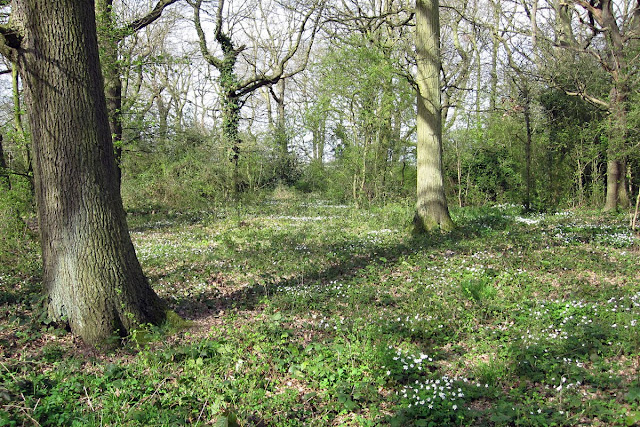 |
| A glade in Thornet Wood, Jubilee Country Park, full of wood anemones. |
 |
| Marsh marigolds, sometimes called kingcups, in Ray's Pond, Jubilee Country Park |
 |
| Toadspawn wrapped round a plant stem in Ray's Pond, Jubilee Country Park, on 3 April 2011. |
Labels:
animals,
environment,
flowers,
insects,
invertebrates,
Jubilee Country Park,
mini-beasts,
walks
Subscribe to:
Comments (Atom)
